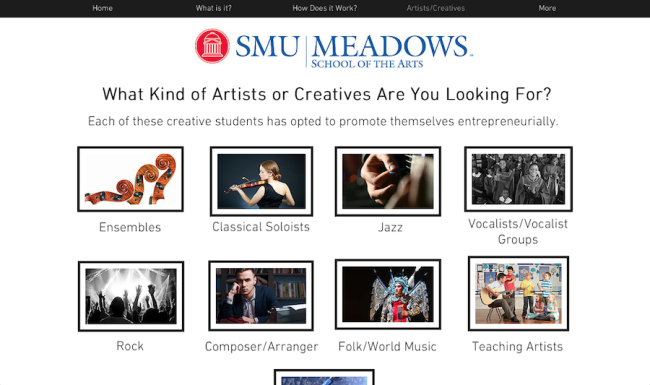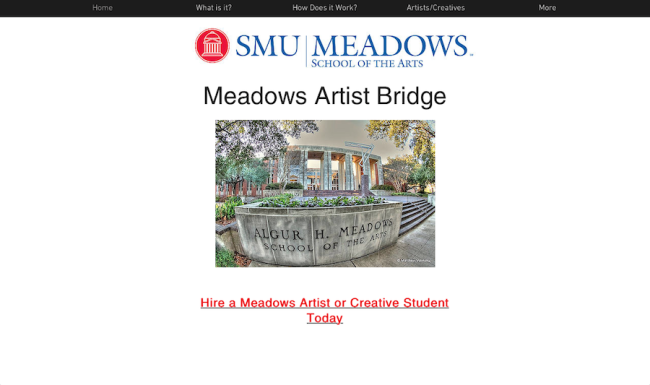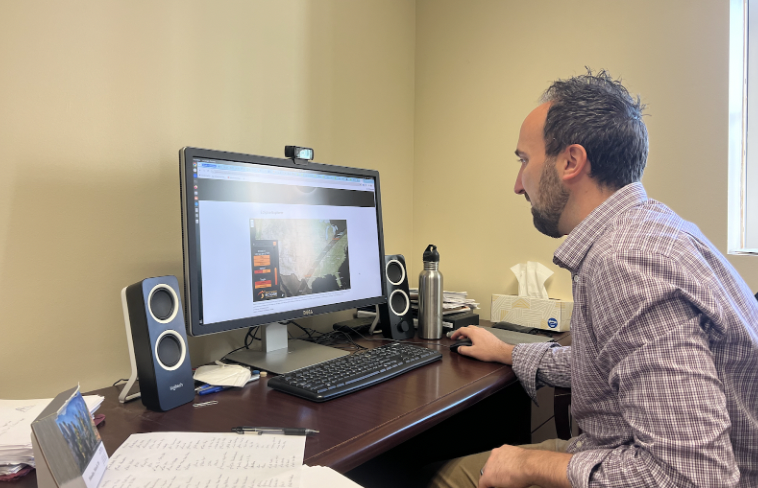Meadows School of the Arts recently launched Meadows Artist Bridge, a web portal that allows students to connect with freelance opportunities in the Dallas area.
“Hardly a day goes by without somebody from the community calling and asking for some type of professional music service,” Meadows Dean Sam Holland said.
Susan Benton, an assistant professor of arts and law who has hired Meadows musicians in the past, believes this new service will far outweigh the previous system.
“It was a bit laborious, and I ended up actually hiring some students from North Texas a couple of years just because it seemed they had a little bit more efficient process,” she said.
The site, launched on Nov. 1 by Director of Arts Entrepreneurship James Hart and Assistant Director for Student Affairs in the Division of Music Dylan Smith, allows potential employers to “shop” for a student artist to fit their needs by looking through the site’s gallery of creatives. The site currently features music students in categories such as ensembles, classical soloists, jazz artists, vocalists and teaching artists.

This serves as a digitized version of the “gig list,” a long standing list of music students to which the administration refers potential employers, and to which they distribute emails about open opportunities. Professor Melissa Murray came to Hart about modernizing the gig list a couple of years ago.
“Immediately I was like ‘well we need to build a website,’” Hart said.
Artist Bridge allows students to market themselves and flips the gig list upside down so the student is the first point of contact. Jobs can range from one-time performances to long term teaching opportunities
“You might even call it the ‘Uber-ization’ of talent,” Holland said.
Although several students have already received opportunities through the site, the project was not met without concerns, including Holland’s worry that the site could mislead clients to think it represents an implicit endorsement of the artist by SMU.
“If so, SMU Legal Affairs you know might not want to see this sort of thing happen,” Holland said. “ Now the truth is it’s been happening all along just using a pencil and paper instead of an online portal.”

Although it currently serves the division of music, other departments such as art and advertising have expressed interest in the site. More disciplines will be introduced in the near future, Hart said.
The division of theater has elected to wait on joining Artist Bridge. The division did not respond to an interview request from The Daily Campus.
However, a concern by some Meadows faculty is the exploitation of students and free labor.
“I want to make sure that if a student is working for an entity outside of the university that they have the skills to negotiate a fair and equitable agreement,” Chair of the Division of Art Noah Simblist said in an email.
Students have concerns as well, including first-year pianist and classical guitarist Jonathan Valenzuela’s worry that his opportunities could decrease because of the more direct contact system. He typically receives two to three gig offers a month, though last month he only got one.
“I don’t know if that’s a result of [Artist Bridge], or it’s just a dry season,” Valenzuela said.
Smith and Benton argue that it could actually open up more doors for students, as employers are able to browse multiple styles of music rather than request one genre.
“Just looking at the site you see different styles of talent you might not even be thinking about,” Benton said.
Student profiles include a photo and biography listing their specializations, skills and experience. Clicking a student’s photo takes the user to their online portfolio where they can find samples of their work, see a student’s hourly rates and contact them directly through an email form, one of the measures Meadows has taken to ensure student safety and privacy online.
“We’ve gone overboard to ensure that confidentiality is protected,” Holland said.
Students also take safety into their own hands by speaking on the phone with potential employers and requesting half of the payment before a gig.
“I also Google people extensively, and companies too because what if it’s like a fake company,” senior cellist Mandy Milliot said.
She plans to remain for the extra year that Meadows is allowing all new graduates to stay on the site. She has already received two gigs through Artist Bridge, one for a teaching opportunity and the other for a dinner party.
In addition to recent alumni, Holland and Hart say that the site could eventually expand to include faculty who wish to participate.
“I know many have expressed interest in doing so,” Hart said. “Right now we want to give our students a competitive advantage. We don’t want to take opportunities away from them by having them compete with people who have been in the industry for 30 years.”
Todd A. Stuart a visiting professor and the director of arts management at Miami University of Ohio’s College of Creative Arts believes the Artist Bridge model could be implemented at other schools.
“If I could implement it tomorrow I would,” Stuart said.
The unemployment rate for artists in the U.S. was 7.1 percent in 2013, according to reporting by the National Endowment for the Arts. The Meadows arts entrepreneurship program tries to teach fine art students how to capitalize on their talents and create opportunities, so they don’t wind up unemployed.
“We really own arts entrepreneurship as an institution,” Holland said. “But practically every art school in the country is trying to get into it one way or another. Because people are waking up to the fact that artists need to learn how to make a living, that waiting tables and taking auditions is not a career strategy.

In 2015 Forbes named SMU No. 14 on a list of America’s most entrepreneurial universities, specifically citing Meadows’ arts entrepreneurship program.
“Artists having always been entrepreneurial, that is not new,” Hart said. “But formalized educational structure in arts entrepreneurship, that is new.”
All first-year fine arts students are required to take the First-Year Arts Community Experience (FACE) course, an orientation class that teaches students basic entrepreneurial and marketing skills for artists.
“That becomes a lens through which you can view your arts education for the remaining three and a half years,” Hart said.
The Meadows marketing department will also be able to use the site’s results to market to parents and prospective students, Hart said.
“All stakeholders involved, from the top of our board of trustees all the way down to the student, everyone benefits through the students working,” he said.
Both students and faculty have ideas on how the site can grow, including developing the site into Meadows’ own social network for students to work with each other.
“I can actually see how it would be really easy to collaborate with people in different departments and stuff,” Milliot said.
Communications disciplines are considering ways their students can leverage the site, and Steve Edwards, director of the Temerlin Advertising Institute, suggests that students could work as freelance graphic designers, conduct focus groups or capitalize on their social media skills, as well as potentially form student groups.
“It would be amazing in five years to say an agency started this way, you know as a group of students getting together building a team,” Edwards said.











